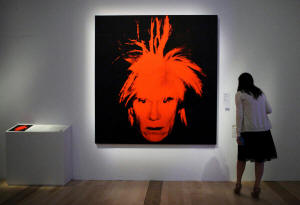U.S. Supreme Court mulls line between art and theft in Warhol case
 Send a link to a friend
Send a link to a friend
 [October 11, 2022]
By Blake Brittain [October 11, 2022]
By Blake Brittain
WASHINGTON (Reuters) - The U.S. Supreme
Court is set to ponder in a case centering on paintings by the late
artist Andy Warhol a question as philosophical as it is legal: what is
the line between art and copyright theft when artwork is inspired by
other material?
The justices on Wednesday will hear arguments in a copyright dispute
between Warhol's estate and celebrity photographer Lynn Goldsmith over
his paintings based on a 1981 photograph she took of rock star Prince.
The case centers on how courts decide when an artist makes "fair use" of
another's work under copyright law. The dispute over the legal boundary
between inspiration and misuse has drawn broad interest for its
implications for artists.
Warhol, who died in 1987, was a central figure in the pop art movement
that emerged in the 1950s, known for his whimsical style and bold use of
colors. He often created silkscreen print paintings and other works
inspired by photos of famous subjects including actresses Marilyn Monroe
and Elizabeth Taylor, Britain's Queen Elizabeth, Chinese leader Mao
Zedong, boxer Muhammad Ali, rocker Debbie Harry and commercial products
including Campbell Soup cans.
Goldsmith photographed Prince for Newsweek magazine in 1981. Warhol made
14 silkscreen prints and two pencil illustrations based on one of
Goldsmith's Prince photos.
Goldsmith, 74, has said she learned of Warhol's works only after
Prince's 2016 death. Goldsmith countersued the Andy Warhol Foundation
for copyright infringement in 2017 after it asked a Manhattan federal
court to rule that his works did not violate her rights. The Supreme
Court will hear arguments in the estate's appeal of a lower court's
decision favoring Goldsmith.

Copyright law sometimes allows for the fair use of copyrighted works
without the creator's permission. A key factor courts consider in
determining fair use is whether it has a "transformative" purpose such
as parody, education or criticism.
The Supreme Court has not ruled on fair use in art since 1994, when it
found that rap group 2 Live Crew's parody of singer Roy Orbison's "Oh,
Pretty Woman" made fair use of the 1960s song. But the court's current
6-3 conservative majority has shown little reluctance in overturning
precedents.
The high court's take on the case is "very hard to predict," said
Harvard Law School professor Rebecca Tushnet, who wrote a brief
supporting Warhol with other copyright scholars.
Megan Noh, who heads the art law practice at the law firm Pryor Cashman,
said she hopes the Supreme Court will clarify how courts determine when
a work is transformative and how much weight this should receive
compared to other considerations.
[to top of second column]
|

A woman looks at a self portrait by Andy
Warhol during the media preview of an exhibition on his works in
Singapore March 15, 2012. REUTERS/Tim Chong/File Photo

'LARGER THAN LIFE'
A federal judge found Warhol's works were protected by the fair use
doctrine, having transformed the "vulnerable" musician depicted in
Goldsmith's work into an "iconic, larger-than-life figure."
In reversing that ruling last year, the Manhattan-based 2nd U.S.
Circuit Court of Appeals said judges should not "assume the role of
art critic and seek to ascertain the intent behind or meaning of the
works" but instead should decide whether the new work has a
"fundamentally different and new artistic purpose and character"
that "stands apart from the 'raw material' used to create it."
The 2nd Circuit decided Warhol's paintings were "much closer to
presenting the same work in a different form," more similar to a
"derivative" work like an art reproduction than a transformative
one.
The Supreme Court's eventual decision could have broad or narrow
implications for fair use depending on the ruling, Tushnet said.
"It's hard to imagine an opinion that says, 'That's right, we don't
consider meaning, so parody is not fair use,'" Tushnet said. "On the
other hand, you can imagine an opinion that says, 'Well, the
criticism has to be really clear' - which would be a threat to
parodists, but the court might not see it that way."
"That's the worrisome scenario for fair use - that if the judge
doesn't 'get it,' it's not going to be fair use," Tushnet added.
The Warhol estate told the Supreme Court the 2nd Circuit's decision
"casts a cloud of legal uncertainty over an entire genre of visual
art, including canonical works by Andy Warhol and countless other
artists."
The estates of famed pop artists Robert Rauschenberg and Roy
Lichtenstein, joined by the Brooklyn Museum, backed the foundation,
telling the justices in a brief that the 2nd Circuit decision would
"impose a deep chill on artistic progress, as creative appropriation
of existing images has been a staple of artistic development for
centuries."
Fan fiction writers, documentary filmmakers and intellectual
property professors also have supported the foundation.
Goldsmith's lawyers told the Supreme Court that a ruling favoring
the foundation would "transform copyright law into all copying, no
right."
President Joe Biden's administration has backed Goldsmith, as have
trade groups for the recording industry, actors and publishers.
(Reporting by Blake Brittain in Washington; Editing by Will Dunham)
[© 2022 Thomson Reuters. All rights
reserved.]
This material may not be published,
broadcast, rewritten or redistributed.
Thompson Reuters is solely responsible for this content. |